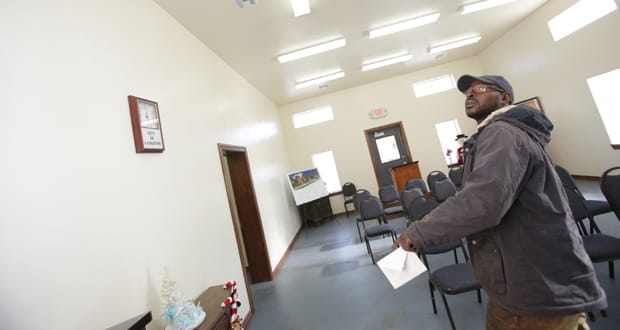
OKLAHOMA CITY – Jason Andrews said he can hear an earthquake, like a large truck, before it hits. Then, he feels a wave pass through Langston’s Town Hall, passing from southeast to northwest.
“When you have a little shaker, you see small cracks that weren’t there before,” he said.
Dozens of quakes have caused minor damage at his home and at work, where he is the city’s code enforcer. He noticed another hairline crack on the Town Hall ceiling on Friday he hasn’t seen before. Scientists who study Oklahoma’s dramatic temblor increase are calling for more research on damage from lower-magnitude shaking Andrews and other residents feel.
Oklahoma Geological Survey Director Jeremy Boak said personal descriptions of events improve his agency’s research. He needs residents to report the earth’s shaking to understand how those quakes behave. The Sooner State’s temblors are likely triggered by oil and gas wastewater injection. But the motion is generally shallower than naturally occurring quakes, so seismic waves travel farther, according to national research published in October. Residents contacted Boak describing damage at their own homes, so there’s a broad perception the ground shaking could have a cumulative effect, he said. His agency is working to understand how to mitigate earthquake risk and what damage could occur.
“I think it would be good for the state to do a formal analysis,” he said. “We need to begin to make the effort to say, ‘What do we know?’”
Boak said he would like to provide a hazard assessment. But he needs structural engineers’ expertise to determine the extent of the problem. OGS recorded 960 quakes magnitude 3.0 and larger in 2015, he said. It recorded about 30 events magnitude 4 and larger. The Oklahoma Department of Transportation inspects roads and bridges within a 5-mile radius of any quake that’s a 4.0 magnitude or larger. It expands its inspection radius if any damage is identified, said spokeswoman Brenda Perry. The agency hasn’t found major damage in recent years, she said. Inspectors did find minor damage to Highway 62 after the 5.6 magnitude temblor in 2011. ODOT is working with contractor Infrastructure Engineers Inc. to review the agency’s inspection procedures. The analysis will help guide the agency to formalize a response policy for quakes, she said.
University of Oklahoma assistant professor of civil engineering Phillip Scott Harvey Jr. is one subcontractor examining ODOT’s procedures. The research team is examining the cumulative effect on state infrastructure from repeated, low-magnitude temblors, and if that could be as damaging as a large quake, he said. Harvey’s work will also provide recommendations on how far inspectors should look from earthquake epicenters.
Benjamin Wallace said there’s likely not a cumulative effect on commercial buildings. The structural engineering director at architecture and engineering firm Frankfurt Short Bruza said new structures are built to codes that include seismic hazards.
“We don’t worry about small windstorms creating cumulative damage,” Wallace said, so he wouldn’t be concerned about small quakes either.
Old, unreinforced masonry buildings may experience cracks in bricks and drywall, he said. Minor quakes, those less than magnitude 4.0, won’t cause catastrophic damage or cumulative failure to structures, he said.
Heavy structures are also more likely to receive damage. A brick spire at St. Gregory’s University was damaged in the 2011 quake near Prague. In Guthrie’s downtown, in which many buildings were built around the turn of the 20th century, those structures have been weakened over time from weather, Wallace said. Employees at several businesses in Guthrie’s historic downtown said they have seen cracks in drywall. Old buildings weren’t designed to withstand seismic forces, so they could face deterioration from minor shaking. A larger temblor could cause damage to already-weakened structures, Wallace said.
“If induced earthquakes caused a larger earthquake than was anticipated before, that would concern me,” he said.
Boak said he would like to gather a consortium of structural engineers, hydrogeologists and petroleum geologists to study and publish what is known. The state may need to take a different approach if researchers don’t find cumulative damage effects, he said.
“If we investigate and find we have a relatively limited number of cases, we may have to look at this on a case-by-case basis, rather than a huge class of property owners in Logan and Payne counties to demonstrate that damage,” he said.
Want to see information about real-time earthquakes, an online catalog search of archives, seismicity maps and statistics? Visit http://earthquake.usgs.gov/
